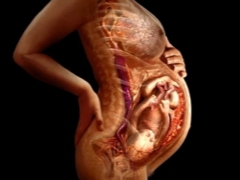Causes of a thin placenta during pregnancy and the effects of hypoplasia
An expectant mother who is expecting a baby during pregnancy can face various diagnoses that can really scare her. One of them is placental hypoplasia.
This article will help expectant mothers to understand what it is, what are the causes of this pathology, and what the consequences may be.
What it is?
Insufficient organ development is called hypoplasia. This condition is characterized by a decrease in mass, diameter and thickness. Also, doctors often call such a placenta "thin", emphasizing that during hypoplasia, the thickness of the placental tissue changes significantly.
Doctors distinguish several clinical variants of this condition.
- Primary hypoplasia. It is connected with the initially impaired implantation process of a fertilized egg to the uterus wall due to certain reasons. In this situation, from the very first days of pregnancy, the placental tissue is small. The functioning of the body, as a rule, is violated.
- Secondary hypoplasia. In this case, the initial formation of placental tissue was correct, and all changes appeared later. Unfavorable symptoms in secondary hypoplasia appear, as a rule, not in the earliest terms, but already in the second half of pregnancy.
The reasons
Scientists identify several groups of causal factors that may contribute to the development of placental tissue hypoplasia. In each case, the causes that contribute to the emergence of this pathology are individual.
Genetics
In case of primary hypoplasia of the placenta, doctors talk about the possible presence of genetic causes, which can also lead to various diseases in the fetus. In some cases, the impact of such causes leads to the development of combined pathologies. Thus, in addition to the formation of hypoplasia of the placenta, defects can develop in the structure of the umbilical cord, as well as various abnormalities in the body of the fetus.
Women who have a family history of the development of genetic diseases should always consult with a geneticist about the likelihood of developing such pathologies during pregnancy.
It is better to do this at the stage of preparing for the conception of a baby. Also, if necessary, you may need to pass several laboratory genetic tests.
Impact of external factors
These factors usually act during the formation of the placenta. It should be noted that placental tissue is quite sensitive to the effects of aggressive environmental factors. If the expectant mother has any concomitant diseases or the immunity is sharply weakened, then the influence of external factors on the actively forming placenta can be extremely negative.
The consequences of various bacterial, viral or fungal infections can also lead to the development of hypoplasia. The inflammatory process, which develops in the body of a pregnant woman as a result of infection, affects the formation of placental tissue, leading to a possible disruption of its development. In this case, as a rule, the placenta begins to slowly develop, and its full functioning is impaired.
Vascular pathology
The presence of arterial hypertension in a pregnant woman is an aggravating factor that threatens the development of placental hypoplasia. Especially unfavorable if during pregnancy, the future mother develops preeclampsia. In this case, the course of pregnancy is significantly aggravated by the possible development of multiple adverse symptoms.
With preeclampsia and persistent arterial hypertension (high blood pressure) there is damage to the walls of blood vessels. This condition during the formation of the placenta is very dangerous, as it affects the speed and intensity of the development of placental tissue. Too long increase in blood pressure also contributes to the fact that the placenta ceases to perform its functions.
Vascular pathologies that affect the possible formation of placental hypoplasia also include:
- various vasculitis;
- atherosclerosis;
- autoimmune pathologies occurring with the vascular component;
- congenital malformations of connective tissue.
Diagnostics
To identify hypoplasia of the placenta during pregnancy allows modern ultrasound diagnostic methods. Usually, with this pathology, ultrasound during the pregnancy is performed several times. This allows doctors to track how much the thickness of the placenta changes during pregnancy.
If doctors need to clarify the intensity of the uteroplacental blood flow, then they also prescribe dopplerography. Using this method, one can also indirectly assess how well nutrients and oxygen are supplied to the children's body. Doppler sonography, like ultrasound, is usually assigned over time.
In practice, there are cases when hypoplasia of the placenta is diagnosed only at 30-32 weeks of pregnancy. Such a “find” leads to the fact that the future mother is under close medical observation.
In hypoplasia of the placenta, physicians must evaluate the general condition of the baby in the womb. To do this, experts calculate the heart rate and evaluate the motor activity of the fetus.
Effects
Pregnancy complicated by placental hypoplasia may occur with the development of various adverse symptoms. This condition can lead to the development of placental insufficiency. In this pathology, the uteroplacental blood flow is disturbed, which leads to impaired growth and development of the fetus.
Violation of the course of fetal development can lead to the fact that various anomalies begin to form in the children's body. If the oxygen deficiency in the child is pronounced, it can even lead to premature birth.
Prolonged intrauterine hypoxia contributes to the fact that the fetus may develop developmental delay syndrome. Children who develop more slowly tend to have less weight at birth, and may also have a number of congenital abnormalities. Complications that may develop with hypoplasia of the placenta, largely depend on the accompanying pathologies that a pregnant woman has. So, if the underdevelopment of the placenta is accompanied by preeclampsia, then the expectant mother can develop pathologies of the kidneys and blood vessels.
Placental hypoplasia can also contribute to various bleeding disorders. In this case, there is a high risk of thrombotic complications. An extremely dangerous complication is the development of thrombosis. In this case, an urgent appointment of drug therapy is required.
In the treatment of hypoplasia of the placenta are used, as a rule, means that improve uteroplacental blood flow. If necessary, drugs are also prescribed that affect blood clotting. Usually vascular drugs are prescribed for a long time.
You can evaluate their effectiveness by performing ultrasound, which are carried out in dynamics.Also an important goal of therapy for placental hypoplasia is the normalization of the general condition of the fetus.
The fact that such a placenta and what functions it performs, see the following video.





















